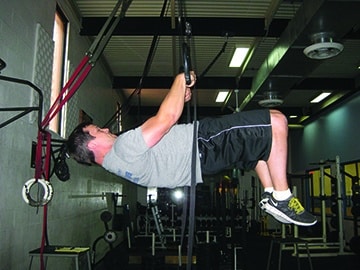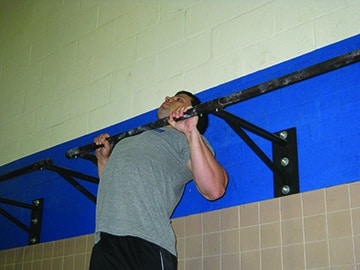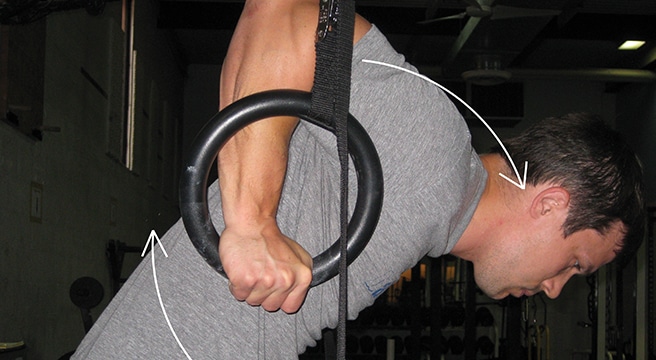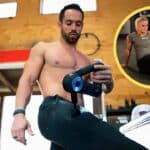Use Your Legs
This is one of the major differences between my muscle-up progression and the progressions I’ve seen at other gyms. While the technique I’m about to lay down is quite well known in the gymnastics world (it’s called a front uprise), it seems relatively unknown in our community. It is so powerful though, that it often results in athletes getting their first muscle-up at my seminar.

WRONG: Body directly under the rings
When using the legs to assist in the muscle-up, many will approach the skill like a kipping pull-up. That is, they will swing their legs back and forth and after they’ve swung their legs to the front, they then violently explode the hips open to raise their body to the rings.Unfortunately, when they do this they put their body directly underneath the rings. (Image 6)
If we remember the wall analogy, we want to go over the top of the wall. By kipping, we put ourselves underneath it – the exact place we don’t want to be! Many get stuck here and are unable to complete the muscle-up. Those that do succeed with their muscle-up, I would argue, are doing so very inefficiently.

Shoulders engaged. Torso Upright. Swinging legs forward
However, what is criticism without an alternative? Instead of violently exploding the hips open, I prefer to swing my legs upward and keep my hips closed – as if I’m swinging my legs into an L-sit pull-up. My torso remains relatively upright, instead of laying back. (Image 7)
By timing the swing of my legs with the pull of my arms, I not only assist in the muscle-up, but I also keep my body behind the rings. Completing the muscle-up is then a matter of moving my head and shoulders around 1/4 of a circle, instead of the 1/2 circle that the kipping muscle-up requires. (Images 8 and 9)

Efficient 1/4 turn vs. inefficient 1/2 turn.
Applying that same concept of a leg swing and upright torso, I can perform a muscle-up over a bar. (Image 12)
The kipping technique for the muscle-up is adopted from the kipping pull-up technique. In that skill, we look to reach the bar. When you want to get over the bar, try the L-sit swing instead.
Shoulder and Wrist Strength
I believe every serious athlete should be able to do a strict muscle-up. It is a display of scapular strength and control and a basic staple in gymnastics training. Even if the athlete performs leg-assisted muscle-ups in competition or training, the strength required for strict muscle-ups will allow the athlete to perform more assisted ones.
That said, I understand that many get their first muscle-up with a leg assist. For those using their legs, they may be encumbered by something other than their technique. Lack of basic strength in the shoulders and wrists makes itself very apparent when attempting muscle-ups.

Shoulders too high. Elbows should be closer to locked out.
When people hang from the rings and start swinging their legs, it is very common to see the athlete’s elbows bend up to 90 degrees. Their shoulders oftentimes come up around their ears. (Image 10)
This position makes it difficult to swing the legs properly, not to mention it would never pass in a CrossFit competition – as rings/knuckles often have to be turned out at the bottom.
What is causing this problem? Oftentimes a combination of weakness in the shoulders and wrists.

Shoulder back and down. Chest touching the bar. No leg help.
To determine if it is shoulder weakness, look at the athlete’s chin-up and pull-up on a regular bar. Are they able to keep their shoulders back and down? Are they able to pull themselves up so that their chest touches the bar, without forward movement of the knees? This is not as easy as it sounds. Getting this strict chest to bar pull-up is a prerequisite for a strict muscle-up and getting close to this standard displays the necessary scapular strength for a leg-assisted muscle-up. (Image 11)
If shoulder strength is adequate, based on the above, then we can determine that it is likely weakness in the athlete’s false grip that is holding them back. Athletes will compensate for a poor false grip by inappropriately bending the arms during the swing. This is because it gives them greater leverage on the false grip by essentially wrapping the wrist over top the ring further than it would normally be.
If you find it’s your false grip, drill false grip hangs in order to strengthen the position. With the rings up high, stand on a box, establish the false grip, pull your shoulders down and back into the proper position and slowly start to remove your weight from the box. You may not remove your feet completely during the first session, but gradually you’ll remove weight until you’re hanging strongly from the false grip.
Lastly, let’s discuss chin-up strength. If you are unable to perform a strong, fast chin-up (and I mean fast), then time is much better spent strengthening that skill than working on the muscle-up. The muscle-up is a sexier skill, but it is made up of foundational skills. Building a stronger foundation, a better chin-up and a stronger false grip, will solve many problems. If your foundation is strong, and you’ve made countless attempts, then it’s time to read this article again. Good luck!
Here’s Jim tackling some strict weighted muscle-ups:
















Just want to say a big thanks to Jim for this. I’ve learned a lot from beastskills over the years and this is probably the best muscle up article going! I’m weighing 190lb at just under 5″9 and skills like the muscle up don’t come easy for me, but seeing him perform weighted muscle ups makes me feel weak. some very good tips